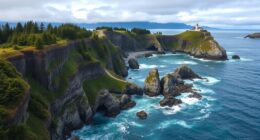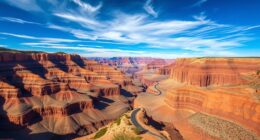Crossing the Nullarbor Plain in Australia is an iconic adventure through a vast, treeless desert rich in history, wildlife, and Indigenous culture. As you drive along the Eyre Highway, you’ll encounter unique landmarks like the Head of Bight and explore limestone caves and rugged cliffs shaped by erosion. Keep an eye out for rare wildlife and sacred sites, but make sure you’re prepared for the remote wilderness. If you continue exploring, you’ll discover more about this fascinating landscape and its cultural significance.
Key Takeaways
- The Nullarbor Plain is a vast, treeless desert spanning South Australia and Western Australia, known for its unique limestone formations.
- The Eyre Highway is the main route crossing the Nullarbor, featuring landmarks like the Eucla Telegraph Station and Nullarbor Links golf course.
- Travelers should prepare with ample water, supplies, and vehicle checks due to remote conditions and challenging terrain.
- The region hosts diverse wildlife such as wombats, quokkas, and Perentie lizards, along with stunning cave systems and erosion-shaped landscapes.
- Indigenous stories and sacred sites along the route highlight the area’s rich cultural and spiritual significance.
The History and Significance of the Nullarbor
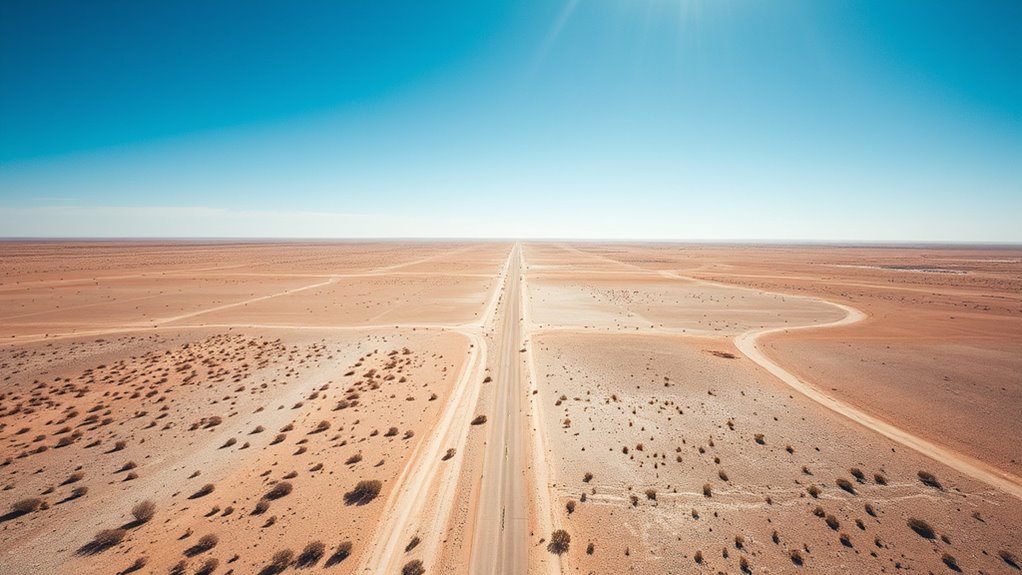
The Nullarbor Plain holds a rich history as one of Australia’s most expansive and arid regions. You should know that its name means “no trees” in Latin, reflecting its treeless landscape. Indigenous Australians inhabited the area for thousands of years, relying on the land’s resources and passing down stories that connect them to the land. European explorers in the 19th century navigated this vast, harsh terrain, opening it up for settlement and travel. The construction of the trans-Australian railway in the early 1900s transformed the region, linking coasts and boosting trade. Today, the Nullarbor holds cultural and historical significance as a symbol of endurance and exploration, reminding you of Australia’s resilient spirit and the deep connections between its people and the land. Additionally, the treeless landscape emphasizes the unique ecological features that have shaped both the environment and the human stories associated with this remote region. This landscape’s extreme climate has played a crucial role in shaping the adaptations of both flora and fauna, further highlighting the region’s ecological significance. Moreover, the region’s history of butter cultural influence in indigenous art and ceremonial practices underscores its profound cultural heritage. The geological formation of the Nullarbor also provides valuable insights into Earth’s natural history, making it a site of scientific interest.
Planning Your Journey Across the Desert

Before you set out, it’s vital to choose the best route based on your timeframe and vehicle capabilities. Make certain you have an exhaustive supplies checklist, including food, water, and emergency gear. Proper planning guarantees a safe, smooth crossing across the Nullarbor Plain. Considering the importance of preparation, understanding the cookie usage and privacy policies can help ensure a smooth online experience when researching your journey. Additionally, selecting appropriate vehicle and tires is crucial for handling the challenging terrain of the desert. Conducting a thorough software quality assurance audit process before departure can help identify potential issues with your vehicle’s systems or navigation tools. For added safety, familiarize yourself with the shower options available at various stops along the way to stay refreshed during long stretches of travel.
Route Selection Strategies
How do you choose the best route across the Nullarbor Plain? It depends on your priorities—speed, scenery, or fuel stops. First, decide if you want the faster, more direct route along the Eyre Highway, or a longer scenic drive through less traveled roads. Second, consider fuel availability; plan your stops to avoid running out in remote areas. Third, check road conditions, especially during wet seasons, as some routes may be closed or rough. Fourth, think about your vehicle’s capabilities; some roads require a sturdy 4WD. Additionally, understanding regional road conditions can help you better prepare for navigation and vehicle management during your crossing. Being aware of desert terrain challenges can further inform your route choice and safety preparations. Knowing about the use of cookies on websites can also help you manage online planning tools and resources effectively. By weighing these factors, you can select a route that matches your adventure style, ensures safety, and keeps your journey smooth across Australia’s vast desert.
Essential Supplies Checklist
Planning your route across the Nullarbor Plain means gathering the right supplies to stay safe and comfortable. You’ll need plenty of drinking water—at least 4 liters per person daily—and enough food for several days, including non-perishable items like canned goods and energy bars. A reliable GPS and detailed maps are essential for navigation, along with a fully charged mobile phone and backup power sources. Don’t forget spare tires, a tire repair kit, and basic tools to handle breakdowns. First aid supplies, sunscreen, hats, and sunglasses protect you from the harsh sun. Emergency equipment like a beacon or satellite phone can be lifesavers. Packing smart ensures you’re prepared for emergencies and can enjoy your journey with confidence. Additionally, understanding forsale 100 products and their availability can help you plan for any last-minute needs or replacements during your trip. Being aware of product spoilage signs can also be useful in case you need to manage food supplies efficiently. Keeping proper hydration techniques in mind will help prevent dehydration in the extreme desert environment. Moreover, knowing the benefits of proper planning can make your crossing safer and more enjoyable.
Essential Tips for a Safe and Enjoyable Drive

To guarantee a safe and enjoyable drive across the Nullarbor Plain, it’s essential to be well-prepared and attentive at all times. First, plan your route carefully and check road conditions regularly. Second, drive during daylight hours to avoid fatigue and poor visibility. Third, stay connected by carrying a satellite phone or emergency beacon, as mobile coverage is limited. Fourth, keep your vehicle in top condition with regular maintenance and enough fuel to reach the next service station. Additionally, share your itinerary with someone beforehand and carry extra supplies, like water and snacks. Staying alert, following safety guidelines, and respecting the environment will ensure your journey is memorable and safe. Proper trip planning makes all the difference in this remote landscape. Regular vehicle maintenance is also vital for preventing breakdowns in such isolated areas. Being aware of the road conditions before and during your trip can help you adapt quickly to unexpected changes.
Notable Landmarks Along the Eyre Highway
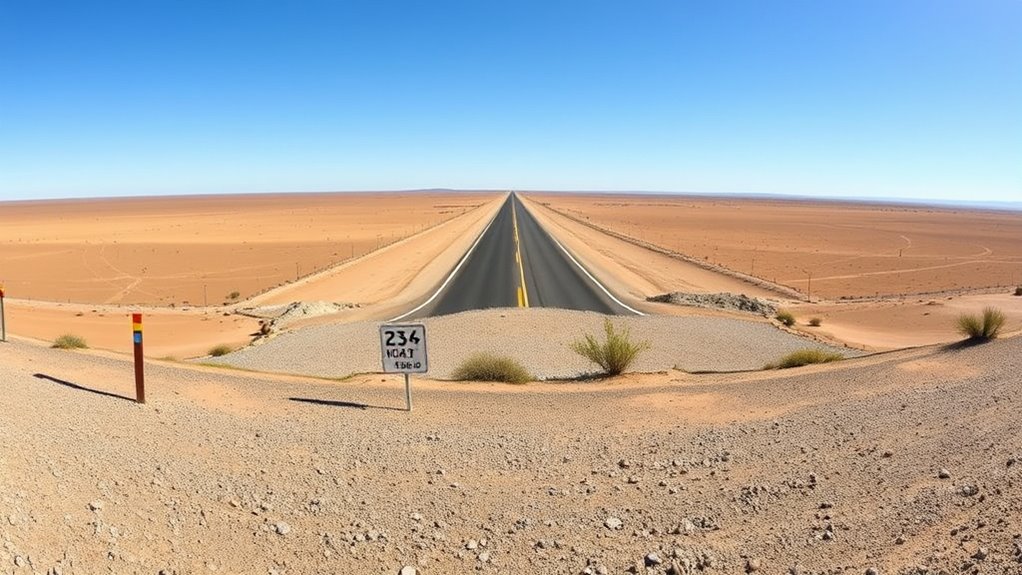
As you travel along the Eyre Highway, you’ll encounter several remarkable landmarks that highlight the region’s natural beauty and cultural significance. One notable site is the Nullarbor Plain itself, a vast, treeless desert that stretches endlessly, offering a stark but breathtaking landscape. Near the border of South Australia and Western Australia, the Eucla Telegraph Station stands as a historic reminder of early communication efforts. The Head of Bight is another must-see, renowned for its spectacular whale-watching opportunities during migration seasons. Additionally, the Nullarbor Links golf course, the world’s longest, provides a unique experience with 18 holes spread across the plain. These landmarks not only enhance your journey but also connect you to the region’s rich history and natural splendor. Developing sustainable tourism can enrich your travel experiences by inspiring new perspectives and deeper appreciation for such remarkable sites. Recognizing the cultural heritage of the area can further deepen your understanding and respect for the local history and environment. Embracing predictive analytics can also help travelers plan more efficient and environmentally responsible visits to these destinations.
Unique Wildlife Encounters in the Nullarbor

Have you ever wondered what unique animals call the Nullarbor home? The region hosts fascinating wildlife you might not see elsewhere. Here are some highlights:
Discover the unique and fascinating wildlife that thrives in the Nullarbor’s expansive landscape.
- Southern Hairy-nosed Wombats – These shy creatures dig extensive burrows and are mostly active at night. Their adaptations for desert life make them a remarkable example of survival in arid environments. Their ability to conserve water and tolerate high temperatures demonstrates their impressive desert resilience.
- Nullarbor Quokkas – Rare, adorable marsupials that often linger near water sources.
- Perentie Lizards – Australia’s largest monitor lizards, basking in the sun and hunting small prey.
- Threatened Malleefowl – Ground-dwelling birds known for their impressive nesting mounds.
As you traverse the plain, keep your eyes peeled—you might catch a glimpse of these extraordinary animals, showcasing the Nullarbor’s surprising biodiversity. Vetted wildlife encounters highlight the region’s ecological significance and the importance of conservation efforts.
Exploring the Caves and Natural Formations
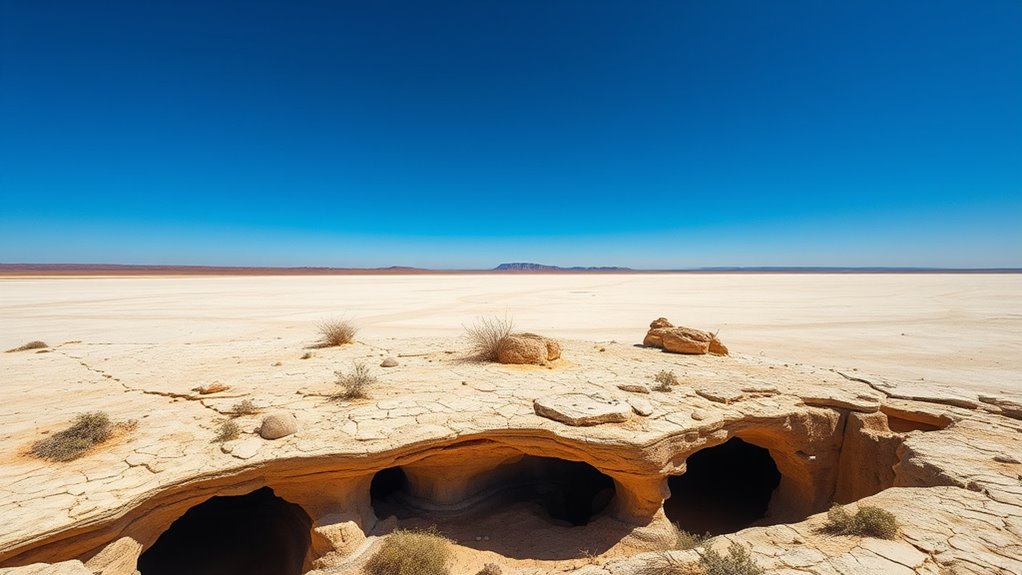
The Nullarbor Plain hides a labyrinth of caves and striking natural formations that invite exploration. As you venture into these underground worlds, you’ll notice the cool, damp air and the intricate limestone structures shaped over millions of years. Many caves feature stunning stalactites and stalagmites, creating a surreal, otherworldly atmosphere. You might stumble upon hidden chambers or narrow passages that challenge your navigation skills. Outside, the landscape reveals unique formations like sinkholes, limestone pavements, and rugged cliffs carved by erosion. Exploring these natural formations offers a sense of discovery and connection with the Earth’s ancient processes. Regularly monitoring climate control options and environmental conditions can enhance your safety and experience during exploration. Remember to go prepared, respect the fragile environment, and enjoy the awe-inspiring beauty that makes the Nullarbor’s underground marvels unforgettable. Additionally, understanding cookies and privacy options nearby can provide a comfortable retreat after your adventurous explorations.
Cultural Heritage and Indigenous Connections
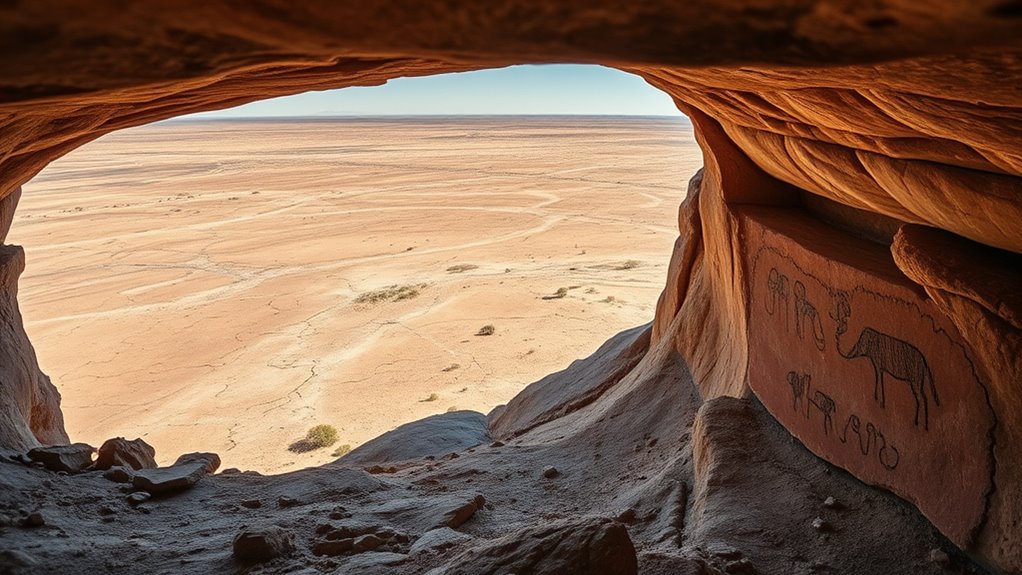
As you explore the Nullarbor Plain, you’ll encounter stories from Aboriginal Dreamtime that connect the land to ancient traditions. Sacred sites hold deep spiritual meaning, and maintaining them guarantees these connections remain strong. Indigenous art continues to express their rich cultural heritage, offering insight into their enduring relationship with the land.
Aboriginal Dreamtime Stories
Ever wonder how the stories that shape Indigenous Australians’ identity have endured for thousands of years? Dreamtime stories are sacred narratives that explain the origins of the land, animals, and people. They’re passed down orally, connecting you to ancestors and the environment. Here’s what makes them special:
- They describe how ancestral beings created the landscape and its features.
- They teach moral lessons and cultural values essential for community life.
- They link you to specific places, making land an integral part of identity.
- They’re performed through song, dance, and storytelling, keeping traditions alive.
These stories are more than tales; they’re living links to Australia’s ancient past, shaping how you see the land and your place within it.
Sacred Sites Preservation
Sacred sites hold profound cultural significance for Indigenous Australians, serving as living connections to their ancestors, stories, and spiritual beliefs. As you traverse the Nullarbor Plain, you must recognize that these sites are crucial to maintaining cultural identity and traditions. Preservation efforts aim to protect these areas from damage caused by development, tourism, and vandalism. Indigenous communities actively work to secure legal protections, often through native title claims and heritage listings, ensuring these sacred places remain untouched. Respectful engagement is essential; you should seek guidance and permission before visiting any sacred sites. Preserving these sites honors Indigenous Australians’ deep spiritual ties and helps pass their stories and connection to the land to future generations.
Indigenous Art Traditions
Indigenous art traditions are a vibrant expression of cultural identity and spiritual connections that have been passed down through generations. These artworks often depict Dreamtime stories, sacred landscapes, and ancestral beings. As you explore, you’ll notice the following features:
- Dot painting techniques create intricate patterns representing waterholes, animals, or spirits.
- X-ray art reveals internal structures of animals, emphasizing connection with nature.
- Sand and body painting serve ceremonial purposes, telling stories or marking rites of passage.
- Carvings and sculptures embody ancestral spirits and sacred symbols, preserving cultural knowledge.
Preparing for the Remote Wilderness Experience
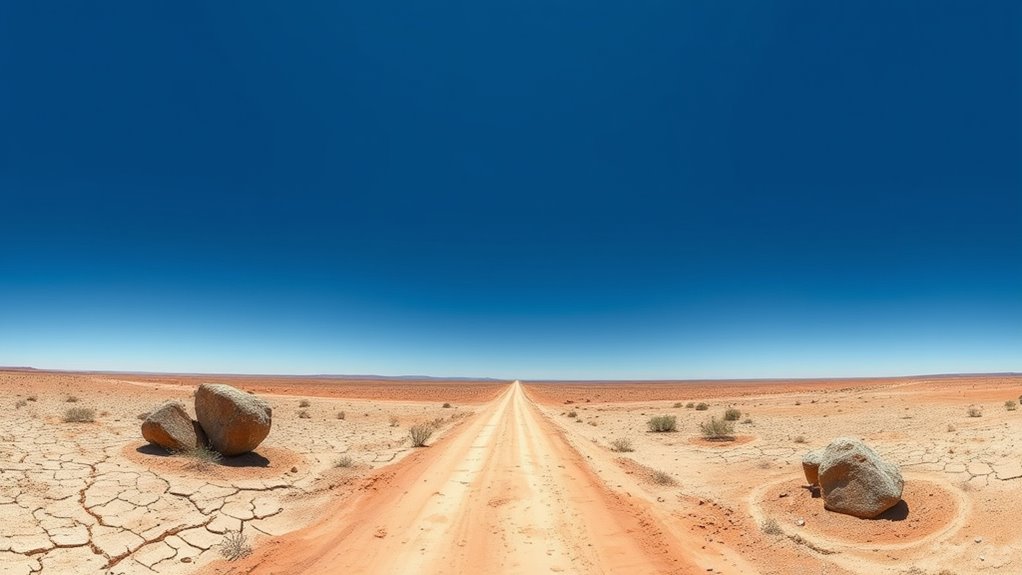
Preparing for a remote wilderness adventure like crossing the Nullarbor Plain requires careful planning and thorough preparation. You’ll need to research the route, check weather conditions, and guarantee your vehicle is in top shape. Pack enough supplies, including water, food, and emergency gear, since services are sparse. Make sure you carry a reliable GPS or navigation device, along with a physical map as backup. Inform someone about your plans and estimated arrival times. Dress appropriately for extreme temperatures and prepare for sudden weather changes. Know how to handle potential hazards, like flat tires or vehicle breakdowns. Staying alert and cautious is crucial in such isolated surroundings. Proper preparation boosts your safety and confidence, making your journey across this vast, challenging landscape more manageable.
Frequently Asked Questions
What Is the Best Time of Year to Cross the Nullarbor?
The best time of year to cross depends on avoiding extreme weather. You’ll want to travel during spring or fall when temperatures are milder, making your journey more comfortable and safer. Summers can get scorching, and winters might bring chilly nights. Planning your trip during these shoulder seasons guarantees you enjoy better road conditions, less heat, and a more pleasant experience overall.
Are There Any Guided Tours Available for Crossing the Nullarbor?
Think of guided tours as your compass in a vast desert. Yes, there are several options available, offering organized journeys across the Nullarbor. These tours typically include expert guides, comfortable vehicles, and planned itineraries, making your adventure safer and more enjoyable. You can choose from multi-day expeditions or shorter trips, depending on your schedule. Booking in advance guarantees you secure your spot on this epic journey.
How Reliable Is Mobile Phone Coverage During the Journey?
Mobile phone coverage can be quite limited in remote areas, so you shouldn’t rely on it entirely. You might experience some service in towns or near main roads, but much of the journey involves stretches with no signal. It’s wise to plan ahead, download maps, and inform someone of your itinerary. Carrying a satellite phone or emergency beacon is a smart idea for safety during the trip.
Can I Find Fuel Stations at All Points Along the Route?
Thinking about fuel stations along your route is like searching for stars in the night sky—mostly reliable but with some gaps. You can find fuel at most major towns and roadhouses, but there are stretches, especially in remote areas, where stations might be few and far between. Plan your fuel stops carefully, and carry extra fuel if you’re venturing into the less populated sections to avoid running dry.
What Safety Precautions Should Solo Travelers Take Crossing the Nullarbor?
When crossing a remote area alone, you need to prioritize safety. Make sure your vehicle is in top condition, carry extra fuel, and have plenty of water and food. Share your travel plans with someone reliable, and keep a charged phone and emergency kit handy. Drive carefully, avoid night travel, and stay alert for changing conditions. These precautions help guarantee you stay safe and prepared during your journey.
Conclusion
As you cross the Nullarbor Plain, remember that you’re venturing through one of Australia’s most expansive and untouched landscapes. Did you know it spans over 1,200 kilometers and holds the world’s largest limestone karst system? Embrace the adventure, respect the environment, and enjoy the solitude. This journey isn’t just about reaching the other side – it’s about connecting with a remarkable natural wonder that’s been shaping Australia for thousands of years.






